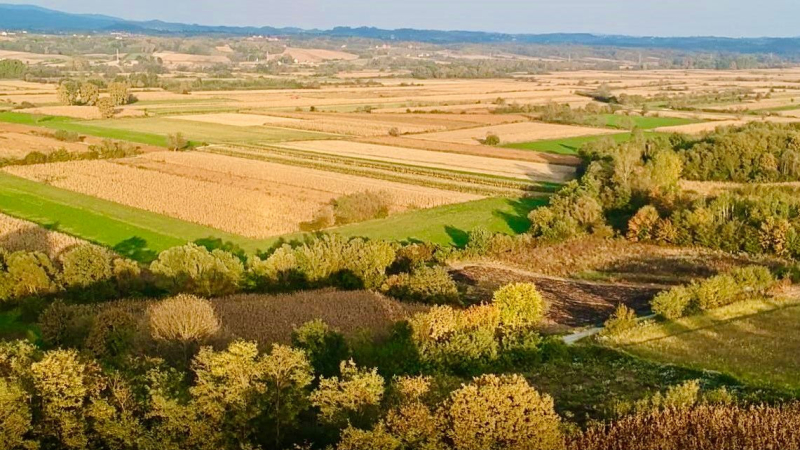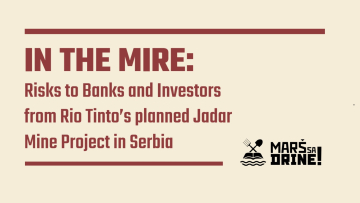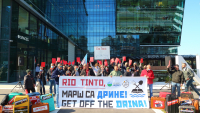Project – Active
This profile is actively maintainedMars sa Drine Collective
Ana Kondic, Mars sa Drine

Project – Active
This profile is actively maintainedMars sa Drine Collective
Ana Kondic, Mars sa Drine
Why this profile?
Rio Tinto's Jadar mine project was planned in a fertile river valley which would be threatened by pollution from the mine, processing centre and associated tailings pond. Hundreds of farmers were threatened with eviction and the circa 19,000 people living in the valley would be left with the danger of toxified water, air and soil. The project faced considerable local and national opposition. As of November 2025, Rio Tinto has suspended the project.
What must happen
Banks and institutional investors with shareholdings or bondholdings in Rio Tinto should conduct meaningful, time-bound engagement with the company to insist it fully addresses the social, human rights and environmental issues presented by the Jadar mine before proceeding with its development.
Further, banks with lending exposure to Rio Tinto must commit to ensure their financing does not support the Jadar project, either directly or indirectly, until all outstanding social, human rights and environmental issues have been effectively resolved.
| Take Action! |
| Rio Tinto, Get Off The Drina! People united for a clean Serbia |
| Sectors | Mining |
| Location |
|
| Status |
Planning
Design
Agreement
Construction
Operation
Closure
Decommission
|
| Website | https://www.riotinto.com/operations/projects/jadar |
Rio Tinto planned to develop a lithium and borate mine in the Jadar Valley, Serbia. The mine would produce battery-grade lithium carbonate, a mineral used in large scale batteries. The proposed development included an underground mine with associated infrastructure and equipment, including electric haul trucks, as well as a chemical processing plant to produce the lithium carbonate. The project was expected to require an investment of USD 2.4 billion.
In January 2022 the Serbian government cancelled Rio Tinto's licences for the mining, citing environmental and social concerns. The company announced it still wanted to explore options to continue the Jadar mine project, and in July 2024 the country's Constitutional Court revoked the government's cancellation. In November 2025, Rio Tinto reportedly suspended the project, saying that it is "entering a phase involving an assessment of project costs and resources." Marš sa Drine called the pause "a tactic", noting that project infrastructure continues to be built.
Impact on human rights and communities
Impacts on agriculture: The Jadar region, the planned location for Rio Tinto’s lithium mine, is one of Serbia's most fertile agricultural areas. . It supports a range of farming activities , from wheat and corn production, to raspberries and plums, honey and dairy farming. To illustrate the scale and sustainability of local food production, Zlatko Kokanovic, vice president of the local landowners association Ne Damo Jadar, alone produces 100,000 litres of milk per year, as well as processing over 40 hectares of crops. The region also generates EUR 85 million in agricultural income. There is a school, post office, church and shops. The valley borders mountains, is surrounded by two rivers, Jadar and Korenita (under which the mine is planned to be built) and is home to thousands of sustainable, multi-generational farms.
The Special Purpose Spatial Plan for the Jadar Project encompasses 2,031 hectares for both the mining and processing facilities, landfill and surrounding infrastructure. It includes 22 villages as well as forests and farmland. To begin construction, the company must acquire 650 hectares of land from 335 private landowners. However, independent cadastral analysis shows that although Rio Tinto claims to own between 40% to 80% of the necessary land, it has only secured approximately 21% of the area required for the first phase of the development.
The destruction of productive farmland would greatly affect the livelihoods of thousands of residents. With the loss of arable land and contamination risks from mining waste containing borates and arsenic, food security in the region is under serious threat. Primarily drilling activities have already contaminated soil and water sources, with samples showing boron levels exceeding national limits by several times. Crops near contaminated wells have shown visible signs of stunting, raising alarm about the long-term viability of agriculture if full-scale mining proceeds.
Impacts on communities: In areas where homes have been purchased by Rio Tinto, properties have been demolished or left derelict, leaving surrounding farms bordered by rows of shattered windows, collapsed roofs and exposed walls left to the elements. In addition to this unsettling contrast, armed security patrols the sites, creating an atmosphere of surveillance and intimidation, particularly acute in a country still healing from the legacy of recent war trauma. The psychological and social toll on remaining residents is severe.
Local property owners report being pressured to sell their land, often under the threat of expropriation. Although Rio Tinto denies ever threatening forced acquisition, internal documents and statements by Serbian officials contradict this claim.
Ne Damo Jadar, a local landowners’ association of over 335 members, has shown considerable opposition to the mine.
Impacts on architectural sites: The Jadar Valley has deep cultural and historical value. It is home to protected immovable monuments and prehistoric archaeological sites, including the 3,500-year-old Paulje burial site, located near the proposed tailings zone. Rio Tinto’s spatial plan includes some of these heritage sites, including immovable cultural property that must remain in situ, but omits others of major significance, raising concerns about irreversible damage to cultural heritage. To date, no proper inventory or protection measures have been taken by Rio Tinto or Serbian authorities. This lack of action violates the rights of local communities to preserve their cultural identity.
Repression of project opponents: Since the project’s revival in min-2024, a coordinated campaign of repression has targeted those opposing the mine’s development. Activists, community leaders, and civil society members have faced intimidation, criminal charges, harassment and threats by state and non-state actors. For instance, Zlatko Kokanović, a leader of Ne Damo Jadar, was interrogated for hours by the Serbian Security Intelligence Agency following protests in July 2024. Similarly, in August 2024, three environmental defenders were arrested during a peaceful protest in Belgrade and later imprisoned on charges of disrupting public order. Despite this escalating climate of fear, public opposition remains widespread. In 2024, hundreds of thousands of protestors across 50 cities mobilised to demand the project’s immediate cessation. This mobilisation is a powerful reminder of recent polling indicating that nearly 60% of Serbians oppose the mine.
Impact on climate
The proposed Jadar lithium mine is framed by its proponents, including Rio Tinto and European Union officials, as a strategic part of Europe’s so-called green transition under the Critical Raw Minerals Act and the European Green New Deal. Lithium demand in the EU is projected to surge by up to 60 times by 2050. This is primarily driven by the expansion of electric vehicle production. In this context, the Jadar project is seen as central to the EU’s effort to localise critical raw mineral sourcing, which has been institutionalised by the 2024 EU-Serbian Memorandum of Understanding (MoU) on sustainable raw materials, battery value chains and electric vehicles. Similarly, Rio Tinto contends that the Jadar mine would position “Serbia as the European hub for green energy”. This green framing quickly becomes undone when viewed through the lens of Serbia’s long-standing candidacy for EU membership, as many would point out that the extractive plans for Jadar region advanced despite widespread opposition on grounds of adverse human and environmental impacts. In fact, the Jadar project would significantly contribute to greenhouse gas emissions through energy-intensive drilling, ore processing, and transportation, much of it powered by Serbia’s coal-heavy electricity grid, which already causes serious pollution. According to scientific research published in 2024 by Đorđević et al, the Jadar project is estimated to emit between “428,000 to 522, 000 metric tonnes of CO2eq/kt per year”. These figures undermine Rio Tinto’s claims, which place annual emissions at approximately 249,000 metric tons of CO2, or 0.4% of Serbia’s total emissions, based on a national baseline of around 60 million metric tons per year. The climate impact of the Jadar mine exposes the transactional nature steering the project.
Impact on nature and environment
Pollution risks: The project involves underground mining beneath the Korenita and Jadar rivers, both tributaries of the Drina River, which flows into Bosnia and Herzegovina. An ore-processing facility would use 1,000 tons of concentrated sulfuric acid per day, diluted with 5,000-6,000 tons of water drawn from the Drina river. Even after treatment, through reverse osmosis, this water would be returned to the Jadar River, carrying residual pollutants including sulphate compounds. The proximity to flood-prone rivers increases the likelihood that contaminants will enter waterways, especially as the Jadar River has flooded as recently as March 2025, causing widespread damage. Rising temperatures pose further risks of floods and droughts.
Dry stacked tailings, or landfilled mine waste, are to be stored in two landfills near the Jadar and Korenita rivers. One site alone would hold 1.3 million tons of tailings annually, amounting to 90 million tons over the mine’s lifespan (90 million tons during mine life span). These sites are located on fertile farmland and forested areas, including zones with five Bronze Age necropolises.
The Serbian Academy of Arts and Sciences has repeatedly warned about the risks of irreversible pollution. In a letter to the Prime Minister, it stated that: “[I]t is highly unlikely that the Investor will prevent the release of toxic and dangerous compounds into the Macva’s underground water horizon, which is estimated to be the largest drinking water-supply source in the whole of Serbia. [...] [M]ining waste heaps will stay there for centuries, slowly releasing – if not decisively contained – toxic compounds and, thus, making the water of the whole region, toxic!”.
These concerns have only intensified since the mine's revival. A paper from the University of Belgrade Faculty of Forestry warned that placing tailings dumps near the Jadar and Korenita rivers creates a constant threat of catastrophic failure during torrential floods, resulting in downstream contamination that will affect Drina, Sava and ultimately Danube rivers which are vital ecosystems and water sources for multiple countries.
The Faculty of Biology at the University of Belgrade issued a strong warning in September 2024 that the biodiversity of impacts of the Jadar project are “extremely significant” and “crucially influence degradation”. It concluded that, even under the best-case scenario, irreversible damage to species populations and ecosystems is likely, while mitigation measures proposed by Rio Tinto were deemed insufficient and poorly defined.
Despite these findings, Rio Tinto has not adequately addressed biodiversity loss in its Environmental Impact Assessments (EIA) submissions. The company divided the project into sub-zones, a practice known as “salami slicing”, to bypass comprehensive assessment requirements under Serbian and EU law. This includes the omission of ore processing, chemical treatment and waste disposal evaluations, despite their cumulative environmental impact. Contrary to the conclusions of the Draft EIAs, which misrepresented independent scientific findings by the Faculty, they clarified that the “optimal and basic measure to prevent a negative impact on the state of biodiversity” is for Rio Tinto to “abandon the planned exploitation and processing of jadarite minerals”.
Key protected areas and species are also missing from official environmental assessments. Notably absent is the Cer Valley, a 19,000 hectare area designated under the International BirdLife program and home to 130 bird species, including endangered ones. Also unmentioned are protected fish species such as the huchen (Danube salmon), found in high concentrations in the Drina River.
Other impacts
The Jadar Project, promoted by Rio Tinto and supported by the Serbian government, promises major economic benefits but delivers minimal returns to Serbia while exposing the country to enormous financial risks. Serbia would receive a paltry €17.4 million annually—just €2.60 per citizen—while funding hundreds of millions of euros in infrastructure solely for Rio Tinto’s benefit, without gaining any ownership or control over the extracted lithium. Meanwhile, Rio Tinto expects to rake in €11.5 billion in net profits over 40 years. The project’s revenue assumptions rely on overly optimistic lithium prices, ignoring market volatility and the shift toward cheaper, less toxic battery technologies like sodium-ion. Serbia also plans to throw €419 million in subsidies at an unproven Slovak battery startup linked to Rio Tinto, with no guarantees of return. In contrast to other countries where Rio Tinto shares ownership or infrastructure costs, Serbia would carry the entire burden—and the liability for potential ecological disasters—alone. Bottom line: the Jadar Project is a high-risk, low-reward deal for Serbia that should be scrapped before it digs a deeper hole.
The financial data listed here refers to total finance for Rio Tinto. The data on bond owners/manager and equity refer to the top 20 investors in each.
In July 2021 Rio Tinto stated it 'committed USD 2.4 billion' to the Jadar lithium mine project. It is expected to finance the project from its own capital, meaning banks and investors exposed to Rio Tinto would be supporting its construction.
Commercial banks finance Rio Tinto (via its subsidiary Rio Tinto Finance) through debt via loans, bonds issuance and commercial paper (see the finance section of Rio Tinto's profile for more details).
Applicable norms and standards
Rio Tinto in Serbia: explained
What's going on in the Jadar Valley in Serbia?
2025
2025-11-17 00:00:00 | Rio Tinto pauses Jadar mine
On November 13th, Bloomberg reported that Rio Tinto had "mothballed" the Jadar lithium project, calling the move "the latest in a series of moves under the miner’s new chief executive officer to streamline its operations and cut costs." Rio Tinto described the project as being placed into “care and maintenance”, according to an internal memo seen by Bloomberg. The decision to suspend the project was taken despite it being designated by the EU as “strategic project” earlier in 2025.
BankTrack has supported the Mars se Drine network of activists to engage with Rio Tinto's largest financiers, urging them to engage the company to ensure the human rights and environmental issues connected with the project were fully addressed. Mars Se Drine warned that "what Rio Tinto calls a pause, we call a tactic.". The group's press release stated: "If the project were genuinely abandoned, administrative procedures would reflect that reality. Instead, the Serbian Ministry of Mining confirms that Rio Tinto’s request for an exploitation license remains active despite the absence of any decisions since 2021. Additionally, roads, gas lines, water lines, and other infrastructure is being built based on the project's spatial plan, and at the Serbian taxpayers’ expense."
Friends of the Earth Europe called it "amazing news for the people’s resistance against mining", but quoted Aleksandra Velimanović of Earth Thrive as calling for caution. “Rio Tinto has all but left the valley”, she says, “It has actually launched a new greenwashing campaign on billboards and is keeping the legal rights over the project.”
2024
2024-08-14 00:00:00 | Jadar project once again on the table, in face of renewed mass protest
In July 2024, Serbia's Constitutional Court revoked the government's previous cancellation of the Jadar mining project, leading to renewed mass protests as the government prepared to give the green light to the project. "If we deliver on everything, [the mine] might be open in 2028," President Aleksandar Vučić told the FT.
2022
2022-01-23 00:00:00 | Serbian government revokes Rio Tinto's mining licenses, but the company wants to continue the Jadar mine project
On Thursday 20th January, the Serbian government announced that it had revoked Rio Tinto's licences to explore for and mine lithium in the country. The decision followed protests that drew thousands over several months. The Prime Minister, Ana Brnabic, was quoted in the Financial Times saying, “As far as project Jadar is concerned, this is an end. Rio Tinto gave insufficient information both to the local community and the government [about the impact of the project].” Campaigners noted that Rio Tinto has announced it has not given up on Jadar and will continue to “explore all options now that elections are out of the way". Civil organizations are concerned about serious legal breaches and it remains to be seen whether the decision to revoke Rio Tinto's permits will be permanent, or prove to have been a political game.



